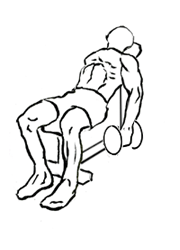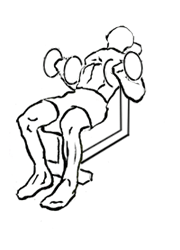Last Updated on September 30, 2022
The incline biceps curl with dumbbell is an essential exercise for anyone looking to build and define their upper arms. By performing this movement on an incline bench, you change the angle and position of your body, which targets the biceps in a unique way, offering a greater stretch and improved muscle activation. It’s a powerful alternative to the standard bicep curl and shares similarities with the preacher curl but provides more flexibility and a longer range of motion.
In this blog, we’ll cover everything you need to know about the incline biceps curl with dumbbells, including the benefits, step-by-step technique, variations, common mistakes, and tips for getting the most out of your workout.
Why Choose the Incline Biceps Curl with Dumbbell?
The incline biceps curl offers several advantages:
- Increased Stretch: By positioning your arms behind your torso, the incline curl maximizes the stretch in the long head of the biceps. This extra stretch leads to greater muscle activation and growth potential.
- Full Range of Motion: The incline bench allows for an extended range of motion, ensuring that your biceps are worked through their full length. This can enhance muscle hypertrophy and strength gains.
- Improved Isolation: Unlike standing curls where other muscle groups might assist, the incline position minimizes momentum, isolating the biceps more effectively.
- Variety and Challenge: Incorporating this variation into your routine keeps your muscles challenged and helps prevent workout plateaus.
Adding the incline biceps curl to your routine can optimize biceps growth, strength, and overall arm definition.
How to Perform the Incline Biceps Curl with Dumbbell
To get the most out of this exercise, follow these detailed steps:
- Setting Up the Incline Bench
- Adjust the bench to a 45-degree angle. This angle is ideal for engaging the biceps while maintaining a comfortable position for your shoulders and back.
- Make sure the bench is stable and secure before starting. Proper setup is essential to avoid unnecessary movement or injury during the exercise.
- Grabbing the Dumbbells and Getting into Position
- Select a pair of dumbbells appropriate for your fitness level. Start with lighter weights if you are new to this movement to focus on form and technique.
- Sit down on the incline bench with your back pressed firmly against the bench pad. Your feet should rest flat on the floor, providing stability and support during the movement.
- Allow your arms to hang down at your sides, holding the dumbbells with your palms facing forward (supinated grip). Your arms should be fully extended, and the dumbbells should be hanging naturally at your sides.
- Curling the Dumbbells
- Begin the movement by slowly curling the dumbbells upward toward your shoulders. Keep your elbows stationary and close to your torso; the only movement should occur at the elbow joint.
- Focus on contracting your biceps as you lift. Squeeze the muscles at the top of the curl to maximize muscle engagement.
- Avoid swinging your arms or using momentum to lift the weights. The movement should be controlled and steady.
- Lowering the Dumbbells
- Slowly lower the dumbbells back down to the starting position in a controlled manner. It’s essential to resist gravity rather than letting the weights drop, as this engages the biceps during the eccentric phase of the movement, promoting muscle growth.
- Ensure that your arms are fully extended at the bottom of the movement to maintain the full range of motion.
- Repetition and Sets
- Perform 8-12 repetitions for 3-4 sets, depending on your fitness goals. For hypertrophy (muscle growth), aim for higher reps with lighter weights, and for strength, use heavier weights with fewer reps.
Pro Tips for Maximum Gains
- Focus on Form: Proper form is crucial for this exercise. Keep your elbows fixed in place throughout the movement. Allowing them to move can shift the emphasis away from the biceps, reducing the effectiveness of the exercise.
- Engage Your Core: Even though you’re seated, engaging your core helps stabilize your body and prevents arching your back.
- Slow Down the Eccentric Phase: The lowering (eccentric) phase of the curl is where most muscle damage and growth occur. Take 3-4 seconds to lower the weights for maximum biceps activation.
- Avoid Heaving the Weights: It’s tempting to lift heavier weights, but doing so with improper form reduces the effectiveness of the movement. Focus on controlled, steady movements for better results.
Common Mistakes to Avoid
- Using Too Much Weight
- One of the most common mistakes is selecting weights that are too heavy, leading to poor form. If you can’t lift the weights without your elbows moving or using momentum, it’s best to reduce the weight.
- Swinging the Arms
- Swinging the arms or using your shoulders to lift the weights reduces the isolation of the biceps. Keep your upper arms stationary and focus on moving only at the elbow joint.
- Rushing Through Reps
- Fast, uncontrolled reps do not engage the muscles effectively. Take your time to perform each curl with precision, focusing on the contraction and stretch of the biceps.
- Incorrect Bench Angle
- Setting the incline bench too low (below 45 degrees) or too high can shift the focus away from the biceps or place unnecessary stress on your shoulders. Ensure the bench is at the proper angle for maximum benefit.
Benefits of the Incline Biceps Curl with Dumbbell
The incline biceps curl isn’t just about aesthetics; it has several functional benefits that contribute to overall upper-body strength and fitness:
- Targets the Long Head of the Biceps: The incline position effectively stretches and engages the long head of the biceps, contributing to fuller, more peaked biceps development.
- Improves Elbow Stability: By isolating the biceps and minimizing momentum, this exercise enhances elbow joint stability, which can improve performance in other upper-body exercises like pull-ups and rows.
- Enhances Arm Strength: Strengthening the biceps through full-range motion builds the strength needed for daily activities and sports performance.
- Prevents Muscle Imbalances: Including incline curls in your routine can help develop both heads of the biceps equally, reducing the risk of muscle imbalances.
Variations to Keep Your Routine Fresh
Once you’ve mastered the standard incline biceps curl, try these variations to add some challenge and variety:
- Single-Arm Incline Biceps Curl
- Perform the curl with one arm at a time to enhance unilateral strength and correct any muscle imbalances. This variation also increases core engagement, as your body must stabilize itself while lifting with one arm.
- Alternating Incline Biceps Curl
- Alternate between curling with your left and right arm. This approach allows you to focus on each bicep independently and ensures you maintain proper form throughout each repetition.
- Incline Hammer Curl
- Instead of using a supinated grip, hold the dumbbells with a neutral grip (palms facing each other). This variation shifts the emphasis to the brachialis and forearm muscles, providing a more balanced arm workout.
- Tempo Incline Biceps Curl
- Slow down the eccentric (lowering) phase to a count of 3-5 seconds while maintaining a quick 1-second lift. This increases time under tension and enhances muscle hypertrophy.
- Incline Curl with Resistance Bands
- For added resistance and variety, combine dumbbells with resistance bands. Secure the band under the bench and loop it around the dumbbells for extra tension during both the lifting and lowering phases.
Safety Tips and Considerations
When performing the incline biceps curl, it’s important to prioritize safety:
- Warm Up Properly: Before starting your workout, warm up your arms and shoulders with light dynamic stretches and warm-up sets to prepare the muscles and joints.
- Maintain Proper Posture: Keep your back pressed against the bench, and avoid arching your spine during the lift. Engaging your core will help maintain a neutral spine.
- Choose the Right Weight: Using a manageable weight allows you to focus on proper form and prevents the risk of injury. Gradually increase the weight as you become more comfortable with the movement.
Incorporating the Incline Biceps Curl with Dumbbell into Your Routine
To maximize the benefits of the incline biceps curl, integrate it into your arm day or upper-body workout. Here are some ways to include it:
- Strength Routine: Perform 3-4 sets of 6-8 reps with heavier weights, focusing on muscle strength. Rest for 1-2 minutes between sets for recovery.
- Hypertrophy Routine: For muscle growth, use moderate weights and aim for 8-12 reps. Incorporate slow eccentric movements for increased muscle tension.
- Superset with Tricep Exercises: Pair the incline biceps curl with a triceps movement like tricep kickbacks for a balanced arm workout.
- Circuit Training: Add the incline biceps curl into a circuit alongside exercises like shoulder presses, lateral raises, and rows to target multiple muscle groups while keeping your heart rate elevated.
Whether you’re a beginner or an advanced lifter, the incline biceps curl with dumbbell can be adapted to fit your fitness level and goals. Remember to prioritize proper form, use manageable weights, and gradually increase resistance to continue challenging your muscles. With consistency and attention to detail, this exercise can become a staple in your arm training routine, helping you achieve the arm size, strength, and definition you’re aiming for.
Final Thoughts
If you’re serious about building your biceps, incorporating different variations like the incline biceps curl with dumbbells can provide the diversity your muscles need to grow. Variety prevents plateaus and ensures your muscles are continually challenged from different angles. So, next time you hit the gym, don’t just reach for the standard curl—try the incline version and feel the difference in your bicep activation and growth.
Remember, results come from consistency, form, and gradually pushing your limits. Keep track of your progress, adjust weights and reps as you become stronger, and enjoy the process of building stronger, well-defined arms.


Exercise images by Everkinetic.






